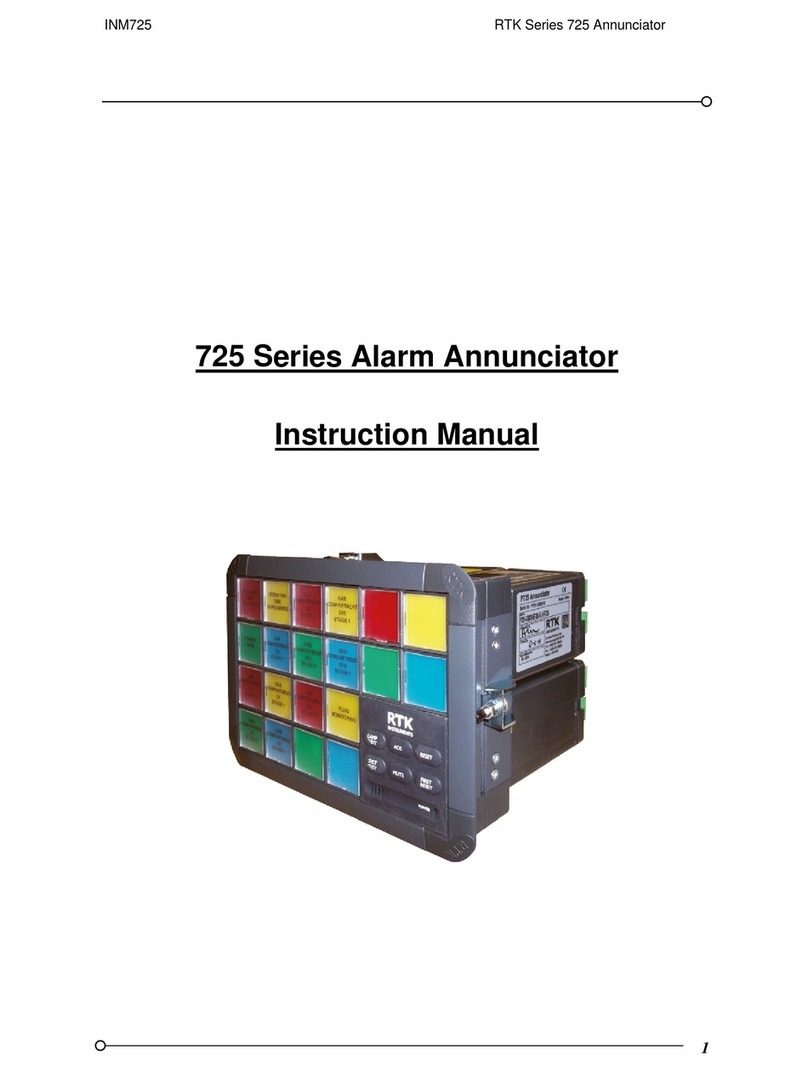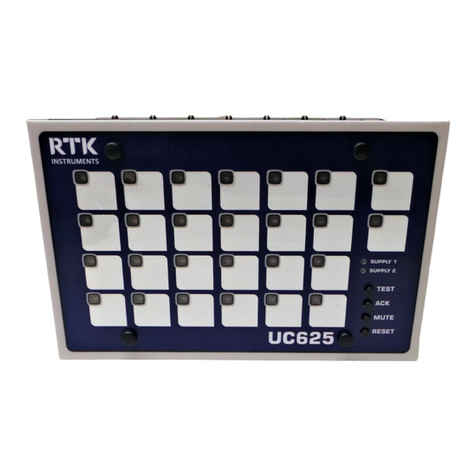RTK Series 725 Annunciator
4
7.3 Panel Mounting Clamps.........................................................................................................27
8. Alarm Sequences............................................................................................28
8.1 Summary................................................................................................................................ 28
8.2 Audible Alarm Grouping.........................................................................................................28
8.3 Ringback Audible ................................................................................................................... 28
9. Additional Features ........................................................................................29
9.1 Automatic Reset..................................................................................................................... 29
9.2 Non-Latch Sequence (No Lock-In)......................................................................................... 29
9.3 Reflash Feature...................................................................................................................... 29
9.4 Ringback Sequence............................................................................................................... 29
9.5 Two Pushbutton Operation .................................................................................................... 29
9.6 First-Up Sequences................................................................................................................ 29
10. Sequence Configuration and Tables...........................................................30
10.1 ISA-Sequence M.................................................................................................................. 30
10.2 ISA-Sequence A................................................................................................................... 31
10.3 ISA-A-4 Sequence ...............................................................................................................32
10.4 ISA-R Sequence - ................................................................................................................ 33
10.5 ISA-F1A Sequence .............................................................................................................. 35
10.6 ISA-F2M-1 Sequence...........................................................................................................36
10.7 ISA-F3A Sequence - ............................................................................................................ 38
11. Options..........................................................................................................40
11.1 General................................................................................................................................. 40
11.2 LED Assemblies (Option LED)............................................................................................. 40
11.3 Tropicalisation (Option TRO) ...............................................................................................40
11.4 Individual Channel Repeat Relays (Option RLY)................................................................. 40
11.5 Individual Channel Dual Repeat Relays (Option RL2).........................................................41
11.6 Customer Specified Response Time (Option CRT**) .......................................................... 41
11.7 Adjustable Response Time (Option AD*).............................................................................41
11.8 Disable Integral Horn (Option DHN).....................................................................................41
11.9 Higher Field Contact Voltages (Option FCxx)......................................................................41
11.10 Supply Input/Output Module (Option SI/O) ........................................................................ 42
11.11 RS485 Serial Communications (Option COM) Part No. CB4468POP1.............................42
11.12 Individual Channel Repeat Relays Powered By The Field Contact Voltage (Option RAV)42
11.13 Three Horn Relay Outputs (Option 3HN)...........................................................................42
11.14 Three Group Relay Outputs (Option 3GP)........................................................................42
11.15 Repeat Pushbutton Output (Option RPB).......................................................................... 42
11.16 Group Relays Follow Inputs (Option GFI)..........................................................................43
11.17 Additional Group Relay Contact (Options 2GA or 2GB)................................................... 43
11.18 Total Group Relay (Option RTG) .......................................................................................43
11.19 SPR Module (Supply-Pushbuttons-Relay Module)............................................................ 43
11.20 Logic Power Connections .................................................................................................. 43
11.21 Signal Supply Voltage Connections................................................................................... 43
11.22 Common Horn/Group/Multi-Function Relay & Remote P.B. Connections......................... 44
12. Large Window Alarm Module Wiring...........................................................45
12.1 Standard Unit Without Repeat Relay Facility.......................................................................45
12.2 Optional Unit With Repeat Relay Facility.............................................................................45
12.3 Large Window Versions Fitted With An Odd Number Of Alarms......................................... 46
12.4 Standard Unit Without Repeat Relay Facility....................................................................... 46
12.5 Optional Unit With Repeat Relay Facility............................................................................. 46
13. Medium Window Alarm Module Wiring.......................................................47
13.1 Standard Version Without Repeat Relay Facility.................................................................47































